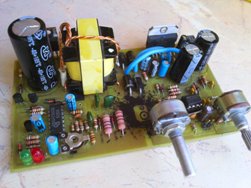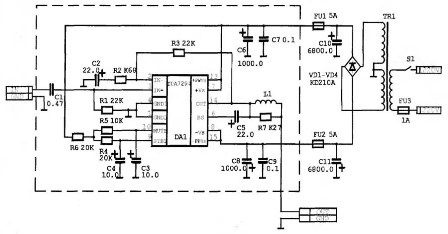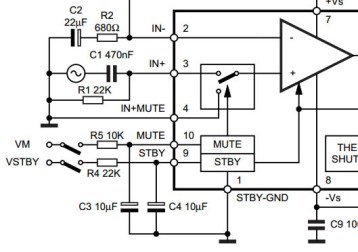Categories: Featured Articles » Practical Electronics
Number of views: 15228
Comments on the article: 1
Electronic amplifiers. Part 2. Audio Amplifiers
 There are so many different amplifiers that in one article, even very briefly, it is impossible to describe them, but sound amplifiers cannot be ignored. Of course, we will not write about tube monsters here, but we will have to remember a few semiconductor structures suitable for independent manufacture.
There are so many different amplifiers that in one article, even very briefly, it is impossible to describe them, but sound amplifiers cannot be ignored. Of course, we will not write about tube monsters here, but we will have to remember a few semiconductor structures suitable for independent manufacture.
Audio Power Amplifiers (UMZCH)
One of the most popular designs for beginner hams is UMZCH. With the seeming simplicity, well, there, just to play the music, it is these UMZCHs that are one of the most complex devices in the repair and independent manufacturing and adjustment. It is enough to take the old Radio magazines and get acquainted with the methodology for setting up amplifiers. But, in fairness, it must be said that some schemes work completely without adjustment. True, there are not very many of them.
In modern conditions, if you do not want to be killed by the pangs of creativity, painstakingly establish a shrew, and the goal is only the end result, so that something “plays”, you should turn to the search for a suitable integrated circuit. There are plenty of such integrated amplifiers, it remains only to choose a suitable price-quality ratio. By the way, many of the modern integrated ultrasonic vibrations have quite decent characteristics, and listening to them is quite pleasant.
This is exactly the chip TDA7294. Based on it, it is quite realistic to assemble UMZCH with a maximum power of 100W. But it’s better not to get carried away too much, and limit yourself to power in the region of about 80W. It is quite possible to achieve such a parameter when powering the microcircuit with a bipolar voltage of ± 30V. The amplifier circuit is shown in the figure. 1.
Picture 1. (click on the picture to enlarge)
The frequency band of the amplifier is 20 ... 20 000 Hz, the nominal input voltage is 800 mV. The harmonic coefficient at an output power of 5W is 0.005%, and at a power of 50W at 0.01% in the entire frequency range, which is good enough for such circuitry. The indisputable advantage of the circuit as a whole is the presence of protection against short circuit at the output, and protection against overheating.
Protection against overheating works quite interestingly: when the case temperature rises to 120 ... 130 degrees, the current of the output stages is limited, slight distortions appear, but the microcircuit does not fail. Although according to the technical documentation it should be so, those who experimented with this microcircuit still do not recommend “squeezing” the maximum power out of it. This can be achieved by using additional transistors at the output, or by assembling a bridge amplifier from two microcircuits. Both options are given in the datasheet - Datasheet.
Another nice feature of the TDA7294 is that the amplifier starts working immediately after turning on the power, without requiring any adjustment, which makes it easy to repeat even for beginner hams. The aforesaid is true for the case if all the parts are serviceable, and no errors have been made during installation.
And here I would like to draw attention to such a "piquant" thing. The microcircuit has a metal plate on the back, designed for mounting to a radiator. For most microcircuits, this plate is connected to a common wire, while for some it “hangs in the air”. For TDA7294, this plate is connected to the negative power pole. Therefore, it is necessary to isolate the microcircuit from the radiator, or install TDA7294 without laying (which is even preferable in terms of heat removal), and isolate the radiator itself from the common wire. You can strengthen the heat sink using forced cooling, - a fan.
This should not be forgotten, despite the fact that the price of TDA7294 does not exceed the cost of a pair of powerful output transistors, which are very easy to burn when setting up an amplifier assembled from discrete components. Such amplifiers, as a rule, are assembled by Hi-Fi and Hi-End style lovers, although there are simple transistor circuits with medium-quality sound.
The amplifier, like most UMZCH, can be powered from an unstabilized source, as shown in the figure. In addition to the diodes indicated on the diagram, it is possible to use KD213A or any others with a maximum forward current of at least 10A. The transformer is suitable with a winding with a midpoint with an idle voltage of 2 * (24..26V) with a load current of at least 5A. For the stereo version of the amplifier, a transformer will need a more powerful one.
The throttle L1 in the company documentation is not provided, you can do without it. But the presence of a choke improves the damping of the amplifier and reduces the risk of self-excitation. The inductor L1 is wound with a wire with a cross section of 0.8 ... 1.2 mm, the diameter of the winding is 8 mm, the number of turns 15 ... 20.
The chip has inputs for remote control MUTE - (muffle), and ST-BY (standby mode). When connecting these inputs, as shown in the figure 1 the amplifier turns on smoothly without clicks on the output. These outputs do not have to be turned on, as shown in the figure. 1. Control signals can be supplied simply from key switches, relays, logic circuits, microcontrollers. On the image 2 all this is conditionally shown in the form of contacts.
Picture 2.
To build such an amplifier is not difficult. On the Internet, you can find many ready-made printed circuit boards on TDA7294.
If you need an amplifier with a power of 10 ... 20 W, then you should pay attention to the common chips TDA2003 and TDA2030. They are designed for such power. A typical connection diagram is given in the technical documentation, there you can also find drawings of printed circuit boards.
Boris Aladyshkin
See also at bgv.electricianexp.com
:


